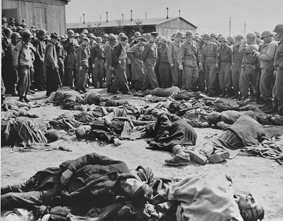
Liberation of Ohrdruf. General Eisenhower is in the middle of the poto, wearing a kepi.
Fifty years have passed since this day but I recall my first impression of the camp called Ohrdruf which I found later was associated administratively with the camp called Buchenwald. Ohrdruf was named after the town of the same name, apparently locally famous for its history of being the place where Johann Sebastian Bach composed some of his works.
Bruce Nickols

Liberation of Ohrdruf. General Eisenhower is in the middle of the poto, wearing a kepi.
April 4, 1945
REPORT ON SURRENDER OF THE GERMAN CONCENTRATION CAMP AT OHRDRUF:
The date was April 4, 1945 and I was on a patrol as a member of the I & R platoon attached to the Headquarters company of 354th Infantry Regiment, of the 89th Infantry Division, 3rd Army U.S.A.
As I recall it was a beautiful spring morning marred by the fact that we were under mortar attack. I remember very well my surprise when I observed Brigadier General Robertson strolling upright down the road. He was an elderly avunular gentleman who thought nonchalance under fire characterized the general officer's role model.
I was impressed but remained prone in the drainage ditch until the atttack ceased. Shortly thereafter, an acquaintance let it be known that a camp had been liberated further up the hill.
Fifty years have passed since this day but I recall my first impression of the camp called Ohrdruf which I found later was associated administratively with the camp called Buchenwald. Ohrdruf was named after the town of the same name, apparently locally famous for its history of being the place where Johann Sebastian Bach composed some of his works.
From the outside, the camp was unremarkable. It was surrounded by a high barbed wire fence and had a wooden sign which read, "Arbeit Macht Frei." The swinging gate was open, and a young soldier, probably an SS guard, lay dead diagonally across the entrance. The camp was located in the forest and was surrounded by a thick grove of pine and other conifers. The inside of the camp was composed of a large 100 yards square central area which was surrounded by one story barracks painted green which appeared to house 60-100 inmates.
As we stepped into the compound one was greeted by an overpowering odor of quick-lime, dirty clothing, feces, and urine. Laying in the center of the square were 60-70 dead prisoners clad in striped clothing and in disarray. They had reportedly been machine gunned the day before because they were too weak to march to another camp. The idea was for the SS and the prisoners to avoid the approaching U.S. Army and the Russians.
Adjacent to the "parade ground" was a small shed which was open on one side. Inside, were bodies stacked in alternate directions as one would stack cord wood, and each layer was covered with a sprinkling of quick-lime. I did not see him, but someone told me that there had been a body of a dead American aviator in the shed. This place reportedly had been used for punishment, and the inmates were beaten on their back and heads with a shovel. My understanding is that all died following this abuse.
I visited some of the surrounding barracks and found live inmates who had hidden during the massacre. They were astounded and appeared to be struggling to understand what was happening. Some were in their 5 tier bunks and some were wandering about.
This was the first camp to be "liberated" by the Allied armies in Germany. Orhdruf was visited by Generals Eisenhower, Patton and Bradley and there are photographs of them observing the bodies of the machine gunned inmates. According to Eisenhower, Patton had refused to visit the punishment shed as he feared he would become ill. He did vomit at a later time.
Further into the camp was evidence of an attempt to exhume and burn large numbers of bodies. There was a gallows, although I really cannot remember whether I saw it or not. I don't remember leaving the camp. I recall being numb after seeing the camp. I had just turned 20 years old and I had read the biographical "Out of the Night." It was a pale and inadequate picture of a German concentration camp by a refugee German author.
I recall becoming very upset when we got back to our quarters, but the whole experience was far beyond my understanding. I wrote a letter to my parents describing the experience which was read at a local gathering of business men. It was widely disbelieved.
Bruce Nickols